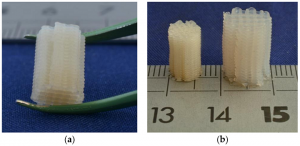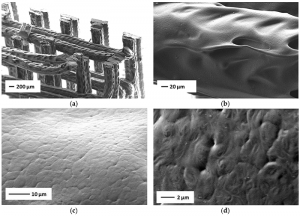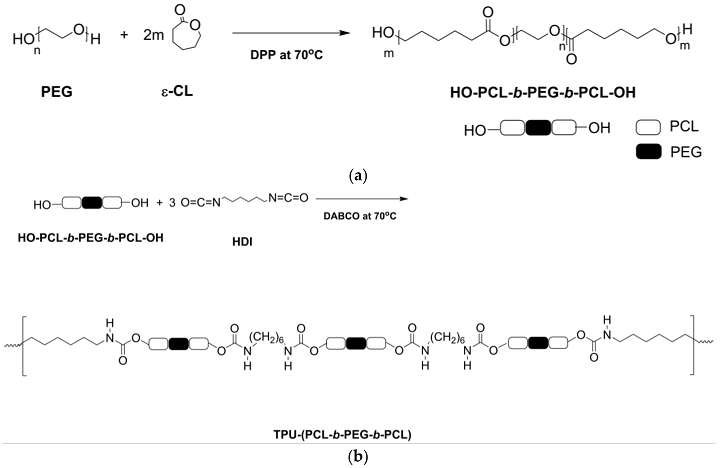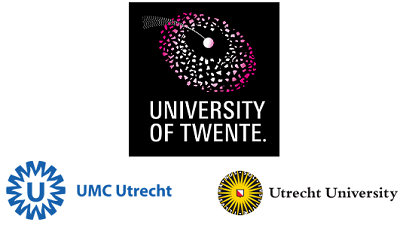Researchers Develop Tough Hydrogels for 3D Printing Applications in Repairing Load-Bearing Soft Tissues
The water-swollen polymer networks we know as hydrogels have many applications in the biomedical industry, but in order to use them to repair and regenerate load-bearing soft tissues, such as cartilage, blood vessels, and tendons, we need to create tougher biodegradable hydrogels. This is just what a collaborative team of researchers from the University of Twente, Utrecht University, and University Medical Center (UMC) Utrecht set out to do.

Designed structure prepared from TPU-(PCL5-PEG10-PCL5) multi-block copolymer by fused deposition modelling: (a) Structure in the dry state and (b) comparison of the structure in dry and hydrated states.
The researchers published a paper, titled “Thermoplastic PCL-b-PEG-b-PCL and HDI Polyurethanes for Extrusion-Based 3D-Printing of Tough Hydrogels,” that details their work in developing tough hydrogels based on the formation of thermoplastic polyurethanes (TPU), which have high toughness and can be processed through extrusion-based 3D printing processes.
TPUs that are based on poly(ethylene glycol), or PEG, can be designed to form physical networks of hydrogels that take up a lot of water – perfect for working with load-bearing soft tissues.
The abstract reads, “Novel tough hydrogel materials are required for 3D-printing applications. Here, a series of thermoplastic polyurethanes (TPUs) based on poly(ɛ-caprolactone)-b-poly(ethylene glycol)-b-poly(ɛ-caprolactone) (PCL-b-PEG-b-PCL) triblock copolymers and hexamethylene diisocyanate (HDI) were developed with PEG contents varying between 30 and 70 mol%. These showed excellent mechanical properties not only when dry, but also when hydrated: TPUs prepared from PCL-b-PEG-b-PCL with PEG of Mn 6 kg/mol (PCL7-PEG6-PCL7) took up 122 wt.% upon hydration and had an E-modulus of 52 ± 10 MPa, a tensile strength of 17 ± 2 MPa, and a strain at break of 1553 ± 155% in the hydrated state. They had a fracture energy of 17976 ± 3011 N/mm2 and a high tearing energy of 72 kJ/m2. TPUs prepared using PEG with Mn of 10 kg/mol (PCL5-PEG10-PCL5) took up 534% water and were more flexible. When wet, they had an E-modulus of 7 ± 2 MPa, a tensile strength of 4 ± 1 MPa, and a strain at break of 147 ± 41%. These hydrogels had a fracture energy of 513 ± 267 N/mm2 and a tearing energy of 16 kJ/m2. The latter TPU was first extruded into filaments and then processed into designed porous hydrogel structures by 3D-printing. These hydrogels can be used in 3D printing of tissue engineering scaffolds with high fracture toughness.”

SEM images of 3D printed structures prepared from TPU-(PCL5-PEG10-PCL5) in the dry state at different magnifications. (a) overview of a printed structure, (b–d) images of the surface of the printed structure at higher magnifications.
The tough hydrogels the team developed used a reaction of poly(ɛ-caprolactone)-b-poly(ethylene glycol)-b-poly(ɛ-caprolactone) triblock copolymers (PCL-b-PEG-b-PCL) and hexamethylene diisocyanate to form TPUs.
In this multi-block copolymer, PEG will make the material hydrophilic, and the hydrophobic PCL component helps the structure fixate during 3D printing, as well as form the network’s crosslinks in the hydrated state.
“The literature on polyurethanes prepared from PCL-PEG-PCL triblock copolymers is very limited,” the researchers explained. “However, the molar mass of these triblock copolymers used was very much lower than the ones we used. In this paper mechanical properties in the wet state and water uptake was not determined. In our case, we used triblock copolymers with much higher molar masses. This leads to materials with excellent processability, and very good mechanical properties in the hydrated state. We also illustrate their processability by extrusion-based 3D-printing using conventional commercially available equipment.”
Several tests and analyses, such as NMR-spectroscopy and Differential Scanning Calorimetry (DSC), were used to confirm the material’s chemical composition, structure, molar mass, and viscosity; tensile testing was also completed. Then, the team cut compression molded polymer films into small pieces and extruded them with a Noztek Pro filament extruder, before collecting the extruded filaments, air-cooling them, and using them to 3D print designed structures on an Ultimaker 2+ 3D printer at 1 mm per second.

Synthesis of (a) hydroxyl-group terminated HO-PCL-b-PEG-b-PCL-OH triblock copolymers and (b) corresponding TPU-(PCL-b-PEG-b-PCL) thermoplastic polyurethane multi-block copolymers.
“Thermoplastic polyurethanes based on PCL-b-PEG-b-PCL triblock copolymers can be prepared by a reaction of the triblock copolymers with hexamethylene diisocyanate. Depending on their PEG content, the synthesized TPU-(PCL-b-PEG-b-PCL) materials can take up large amounts of water of more than 500%. This allows them to be used as biodegradable thermoplastic hydrogels. Furthermore, these materials were shown to have excellent mechanical properties displaying high tensile strength, elongation at break, toughness and tear resistance in the dry as well as in the highly water-swollen state,” the researchers concluded. “This work has shown that these advanced thermoplastic materials can readily be processed into designed hydrogel structures by fused deposition modelling using conventional equipment, thus allowing them to be used in a variety of biomedical applications. Future work will address optimization of the printing process and the properties of built structures in more detail.”
Co-authors of the paper are Aysun Güney, Christina Gardiner, Andrew McCormack, Jos Malda, and Dirk W. Grijpma.
Discuss this research and other 3D printing topics at 3DPrintBoard.com or share your thoughts below.
Subscribe to Our Email Newsletter
Stay up-to-date on all the latest news from the 3D printing industry and receive information and offers from third party vendors.
You May Also Like
3D Printing Unpeeled: New Arkema Material for HP, Saddle and Macro MEMS
A new Arkema material for MJF is said to reduce costs per part by up to 25% and have an 85% reusability ratio. HP 3D HR PA 12 S has been...
3D Printing News Briefs, January 20, 2024: FDM, LPBF, Underwater 3D Printer, Racing, & More
We’re starting off with a process certification in today’s 3D Printing News Briefs, and then moving on to research about solute trapping, laser powder bed fusion, and then moving on...
3D Printing Webinar and Event Roundup: December 3, 2023
We’ve got plenty of events and webinars coming up for you this week! Quickparts is having a Manufacturing Roadshow, America Makes is holding a Member Town Hall, Stratafest makes two...
Formnext 2023 Day Three: Slam Dunk
I’m high—high on trade show. I’ve met numerous new faces and reconnected with old friends, creating an absolutely wonderful atmosphere. The excitement is palpable over several emerging developments. The high...
































